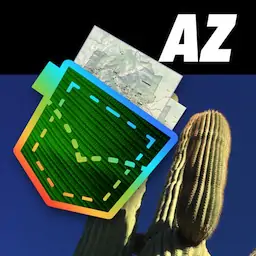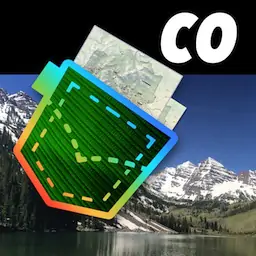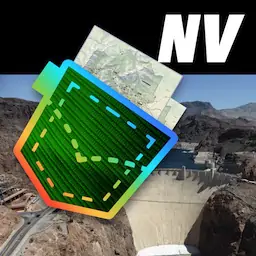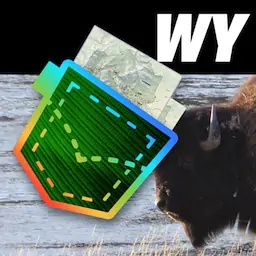NevadaNHT Auto Tour Guides |
The National Historic Trail route across Nevada. Published by the National Park Service (NPS).
featured in
covered parks
National Trails Intermountain Region
National Park Service
U.S. Department of the Interior
National Historic Trails
Auto Tour Route Interpretive Guide
Across Nevada
California National Historic Trail
Pony Express National Historic Trail
By the time they reached the Humboldt Sink, or Forty-mile Desert,
many emigrant pioneers had little food, exhausted livestock, and
broken wagons.
[Cover photo] Forty-mile Desert
NATIONAL HISTORIC TRAILS
AUTO TOUR ROUTE
INTERPRETIVE GUIDE
Across Nevada on the Humboldt Route and
The Central Route of the Pony Express
Prepared by
National Park Service
National Trails Intermountain Region
www.nps.gov/cali
www.nps.gov/oreg
www.nps.gov/poex
www.nps.gov/mopi
NATIONAL PARK SERVICE
U. S. DEPARTMENT OF THE INTERIOR
April 2012
Table of Contents
‘MOST CORDIALLY I HATE YOU’:
THE HUMBOLDT RIVER
••••••••••••••••••••
2
THE GREAT BASIN
••••••••••••••••••••
4
SEEKING MARY’S RIVER
••••••••••••••••••••
5
APPROACHING THE HUMBOLDT
• • • • • • • • • • • • • • • • • • • • 11
PRELUDE TO MURDER
• • • • • • • • • • • • • • • • • • • • 15
THE HUMBOLDT EXPERIENCE
• • • • • • • • • • • • • • • • • • • • 18
WEST TO STONY POINT
• • • • • • • • • • • • • • • • • • • • 21
THE POLITICS OF HUNGER
• • • • • • • • • • • • • • • • • • • • 24
A FLASH OF THE BLADE
• • • • • • • • • • • • • • • • • • • • 27
‘HEARTILY TIRED OF THE JOURNEY’
• • • • • • • • • • • • • • • • • • • • 29
THE HUMBOLDT SINK
• • • • • • • • • • • • • • • • • • • • 33
THE Forty-mile DESERT; or,
HOW TO KILL AN OX
• • • • • • • • • • • • • • • • • • • • 35
INTO THE SIERRA NEVADA
• • • • • • • • • • • • • • • • • • • • 42
THE PONY BOYS
• • • • • • • • • • • • • • • • • • • • 44
CHANGE IN THE GREAT BASIN
• • • • • • • • • • • • • • • • • • • • 51
Sites & Points of Interest:
Setting Out
• • • • • • • • • • • • • • • • • • • • 53
Navigating the California Trail Across Nevada • • • • • • • • • • • • • • • 54
Tips for Trailing Across Nevada
• • • • • • • • • • • • • • • • • • • • 56
AUTO TOUR SEGMENT A:
WEST WENDOVER AND JACKPOT, NEVADA, TO CALIFORNIA
(California Trail)
• • • • • • • • • • • • • • • • • • • • 58
AUTO TOUR SEGMENT B:
BLACK ROCK DESERT, RYE PATCH RESERVOIR TO GERLACH, NEVADA
(Applegate and Nobles Trails)
• • • • • • • • • • • • • • • • • • • • 77
AUTO TOUR SEGMENT C:
WEST WENDOVER, NEVADA TO CALIFORNIA BORDER
(Pony Express Trail and Carson and Walker River-Sonora
Routes of the California Trail)
FOR MORE INFORMATION:
• • • • • • • • • • • • • • • • • • • • 86
• • • • • • • • • • • • • • • • • • • • 102
Introduction
M
any of the pioneer trails and other historic routes
that are important in our nation’s past have been
designated by Congress as national historic trails. While
most of those old wagon roads and routes are not open
to motorized traffic, visitors can drive along modern
highways that either retrace the original route or closely
parallel it. Those modern roads are designated as Auto Tour Routes.
They are marked with “National Historic Trails” highway signs to help
today’s travelers follow the routes used by the pioneers who helped to
open the American West.
This interpretive publication guides visitors along the Auto Tour
Routes for the California and Pony Express national historic trails as
they cross the state of Nevada from east to west. Site-by-site driving
directions are included, and an overview map is located inside
the back cover. To make the tour more meaningful, this guide also
provides a historical overview of the two trails, shares the thoughts
and experiences of emigrants who trekked to California, and
discusses how the westward expansion impacted native peoples of
what is now Nevada.
Individual Auto Tour Route interpretive guides such as this one are
in preparation for each state that the Oregon, California, Mormon
Pioneer, and Pony Express trails pass through. In addition, individual
National Park Service brochures for the four national historic trails
are available at many trail-related venues and can be requested from
the National Trails Intermountain Region Salt Lake City Branch
Office at ntsl_interpretation@nps.gov. Each brochure includes a
color map of the entire trail and provides an overview of information
about each of the trails. Additional information can also can be found
on individual trail websites. For links see page 102.
Auto Tour Route Interpretive Guide
Nevada
‘MOST CORDIALLY I HATE YOU’:
THE HUMBOLDT RIVER
T
he four great rivers that led covered wagon pioneers into the far
West each had a personality all its own.
There was the gritty prairie Platte, cantankerous but dependable;
the brooding, basalt-shrouded Snake, menacing as a stranger with a
hostile stare; and the broad-shouldered Columbia, the Big River of
the West, confident and athletic, striding purposefully toward the
Pacific Ocean.
But the Humboldt.
The Humboldt was sullen and spiteful, a mocking mean joker that
lured emigrants deep into the desert, swindled them of all they
possessed, and left them abandoned at last on a dead lake floor of
silt and salt. Along its twisting course across today’s Nevada, the foul
Humboldt River drove many California-bound travelers to despair
and at least two to bitter poetry.
Meanest and muddiest, filthiest
Stream, most cordially I hate you
—Dr. Horace Belknap, 1850
Farewell to thee! Thou Stinking turbid stream
Amid whose waters frogs and Serpents gleam
Thou putred mass of filth farewell forever
For here again I’ll tempt my fortunes never
—Adison Crain, 1852
The Humboldt was, as Western historian Dale Morgan wrote, “the
most necessary river of America, and the most hated.”
Hated for its deep, reedy sloughs, which trapped and drowned thirstcrazed livestock. Hated for the stinking broth of mud and decay that
dawdled down its meandering channels. Hated for the buzzing, biting
insects and raucous coyotes that mobbed its banks. Hated for its willow
thickets that concealed expert archers with poison-tipped arrows.
2
Auto Tour Route Interpretive Guide
Nevada
Yet necessary, because the Humboldt River ambled in a curving
diagonal from northeastern Nevada toward the gold fields of
northern California. Necessary because it was a long, reliable (if
repulsive) drink of water across some 300 miles of desert. Necessary
because it enabled thousands of Americans to go west and help build
a nation stretching from coast to coast.
Necessary, too, for the survival and independence of the native
peoples who lived, hunted, and harvested along its length. The
Humboldt and its marshes, meadows, and lake were beautiful, not
baleful, to the Shoshones and Paiutes. These waters provided them
drink, a bounty of waterfowl, fish, and food plants to feed their
families, and willows to make baskets and dwellings.
For gold seekers and emigrating settlers, the Humboldt River was a
necessary evil. For the native people of the Great Basin, it was lifegiver and home.
Oxbows along the Humboldt River.
3
Auto Tour Route Interpretive Guide
Nevada
THE GREAT BASIN
M
ountain men who probed the country between the Rocky
Mountains and the Sierra Nevada recognized the region to
be a vast, bowl-like depression—a basin. Within that Great Basin
rise hundreds of north/south-trending mountain ranges separated
by broad valleys of sagebrush, greasewood, and saltbush. “A barren
country,” observed the mountain men, “a Country of Starvation.”
Explorers had more bad news for pioneers seeking a wagon route to
California: the legendary Buenaventura River was just that—a legend.
Early mapmakers had conjectured that the unknown interior would
be drained by a great river, the “Buenaventura,” flowing west out of
the Rocky Mountains and emptying into San Francisco Bay. But in
fact the streams of the Great Basin are landlocked. Not one has an
outlet to the sea. Instead, they all drain to the basin floor and pool
into lakes and marshes or gradually dwindle and finally expire in
mudflats known as sinks.
Then too, most of the Basin’s streams run north or south, parallel to
the mountain ranges and not in the direction emigrants wished to go.
The only river to thread its way west among the ramparts of Nevada
is the maligned Humboldt, also known to 19th-century trappers
and emigrants as the Unknown, the Swampy, the Barren, Paul’s,
and Ogden’s River. It was best known as Mary’s River until 1845,
when explorer John C. Frémont renamed it after the distinguished
German geographer Alexander von Humboldt. Whatever its name,
this watercourse is not the lusty
Buenaventura of mapmakers’
imaginations, for it is basinbound and dies a desert death
miles short of the Sierra Nevada.
Humboldt River Valley, by Daniel
Jenks, ca. 1859. Courtesy Library of
Congress.
4
But it is wet and it is westerly,
and so in 1841 the first
California-bound overland
emigrants followed the
Humboldt River across the
Great Basin.
Auto Tour Route Interpretive Guide
Nevada
SEEKING MARY’S RIVER
B
arely beyond the Great Salt Lake Desert, about two-thirds of the
way from Missouri to California, the emigrants of the BidwellBartleson Party found themselves undeniably, agonizingly, belly deep
in trouble. These 32 men, one woman, and a child were lost in the
desert near today’s Utah/Nevada border. It was mid-September 1841.
Their provisions were gone, their draft animals failing, their summer
spinning alarmingly toward autumn, and some 500 miles yet lay
between them and their destination.
As the first coveredwagon pioneers to
strike out overland
for California, they
had no wagon trail
to follow and no
useful map of the
route. Mountain man
Thomas Fitzpatrick
had guided them
safely from the
“Emigrant Party On The Road To
Missouri River to Soda Springs California” Courtesy Library of Congress.
in present-day Idaho, but he
was not going on to California.
The emigrants would have to
continue west on their own, and best of luck to them, for few white
men had yet explored the country between the Great Salt Lake and
the Sierra Nevada.
Fitzpatrick and the trappers from nearby Fort Hall could offer only
hearsay about the region. They knew nothing of any Buenaventura
River, which the emigrants had hoped to float from the Great Salt
Lake to California. The mountaineers had heard of Mary’s River,
and they offered some vague and ominous advice on how to find its
headwaters: first go south, then turn west, and turning in the wrong
place would mean extreme peril and likely death in the wilderness.
5
Auto Tour Route Interpretive Guide
Nevada
One month and 200 miles after bidding farewell to Fitzpatrick at Soda
Springs, the Bidwell-Bartleson Party was in desperate straits. Ben and
Nancy Kelsey, parents of a baby daughter, left their two wagons on
the desert near present-day Lucin, Utah, on September 12 because
their oxen were too weak to pull. They continued on with pack
mules, driving their cattle along as beef-on-the-hoof. Four days later,
near today’s I-80 at Oasis, Nevada, the other emigrants prepared to
abandon their wagons, as well.
As the men crafted packsaddles for their mules, horses, and oxen, a
joyful old Indian man, likely Goshute, walked into camp and told by
gestures that he had dreamt of their coming. Charmed, the emigrants
made him gifts of items they could not pack, and Nicholas Dawson
later recounted that the men “helped” the laughing stranger to put
on unfamiliar articles of clothing “hind-part fore [and] upside down
until they could get no more on.” Taking no offense in the horseplay,
the elderly man accepted each precious gift with a broad smile and a
lengthy prayer of thanks. It was a happy meeting of mutual goodwill
that, sadly, would not set the tone for intercultural relations in the
years to come.
We signed to our aged host that the wagons and everything
abandoned were his, all his, and left him circumscribing the
heavens—the happiest, richest, most religious man I ever saw.
—Nicholas “Cheyenne” Dawson, 1841
Now the emigrants urgently needed to make
their way to the mysterious Mary’s River and
over the Sierra to California. The first task at
hand was to load necessities onto the livestock.
John Bidwell claimed that none of the men had
so much as witnessed a horse being packed
(experienced packers know that balancing and
securing an awkward bundle onto the back of
an animal is harder than it looks). Cinching a
pack to an ox is especially difficult because,
John Bidwell became one of
unlike horses and mules, oxen lack wellCalifornia’s leading citizens.
Courtesy Utah State Historical Society.
defined withers, the high, bony prominence
between the shoulder blades that keeps a
6
Auto Tour Route Interpretive Guide
Nevada
saddle from slipping to one side. Predictably, the men’s first efforts
resulted in a bucking, bawling, braying brawl.
It was but a few minutes before the packs began to turn; horses
became scared, mules kicked, oxen jumped and bellowed, and
articles were scattered in all directions.
—John Bidwell, 1841
Dawson noted grimly: “There was one thing we had no trouble to
pack—our provisions.” That is because they had none. The party had
finished off the last of their supplies before reaching the Great Salt
Lake several weeks earlier. Since game was scarce in this country, the
emigrants had begun butchering their weakest oxen. Now about 20
cattle remained. When those were gone, they would have to eat the
mules and horses.
As the group resumed their westward march, those emigrants who
packed their belongings on the backs of plodding oxen fell to the
rear of the caravan while those with horses and mules rode miles
ahead, too fast for the cattle to keep up. This inequity soon would
fuel resentments and eventually split the party, but for now they all
focused on moving west, deeper into the Great Basin, toward the
elusive Mary’s River.
Range after range of
mountains forced the
migrating band to stairstep anxiously south,
west, and south again,
until the emigrants
found themselves in a
dry camp at the foot of
the Ruby Mountains in
today’s eastern Nevada.
They gazed worriedly
into the wasteland.
Trappers from Fort Hall
had warned of a dangerous
desert to the south. Could
Pioneer wagon road through the dry
uplands between the Humboldt Range and
the Ruby Mountains.
7
Auto Tour Route Interpretive Guide
Nevada
this be it? Had they gone too far? In desperation, the party turned
abruptly west, pushed over the Rubys at Harrison Pass, and then
followed a creek northward to regain their course. On September 24,
eight days after abandoning their wagons in the desert, the emigrants
struck a larger stream. Although they did not know it, this was the
south fork of Mary’s River, of the soon-to-be Humboldt. A week
later the party emerged from the mouth of a twisting canyon about
eight miles west of present-day Elko, where their stream emptied into
a west-flowing channel. It was, at last, their necessary river and the
future route of the California Trail.
Day by day the river led the travelers deeper into the barrens. Grass
and game were in short supply. The worn-out oxen, those walking
commissaries, were growing too weak to carry their packs and too
skinny to make a good meal. It was early October, the Sierra lay ahead,
the emigrants were hungry, and Mary’s River itself appeared to be
drying up.
The Humboldt River drains into the desert south of
Lovelock, Nevada.
8
Auto Tour Route Interpretive Guide
Nevada
The country on both sides appeared a desert. The river seemed to be
dwindling instead of receiving big tributaries to swell its flood and
guide us onto the plains of California and on to the Pacific, where
our suffering and troubles would end, and where we could eat, eat,
eat—and something that had some fat in it.
—Nicholas “Cheyenne” Dawson, 1841
Those of the party who rode horses and mules grew increasingly
frustrated with the doddering ox-drovers. They wanted, needed, to
move quickly and reach California before starvation or winter put an
end to them, but the famished, lumbering oxen had only two speeds:
slow and stop. Neither love nor loyalty bound the band together; it
was a simple matter of economics. The ox-drovers owned the food.
Their oxen were the food. In desperation, eight men of the party, led
by wagon master John Bartleson himself, commandeered the lion’s
share of a fresh-butchered ox, mounted up, and made tracks for the
mountains, leaving their comrades standing aghast in the desert dust.
The 26 emigrants left behind gathered up their remaining cattle and
plodded onward. Helpful Paiute Indian guides piloted the group
on down Mary’s River, through the marshy Big Meadows at today’s
Lovelock, and past the Humboldt Sink, where the stream surrenders
at last to the sun. The travelers next made passage across the brutal
Forty-mile Desert and then turned south toward the west fork of the
Walker River.
On October 15, ten days after splitting up with Bartleson’s riders,
the ox-party made camp at the foot of the Sierra in the vicinity of
present-day Wellington, Nevada. Their Paiute guides, unable or
unwilling to lead them into the Sierra, slipped into the night, leaving
the emigrants to determine their own fate. Several of the emigrant
men were preparing to scale nearby heights, hoping to spot a likely
passage through the mountains, when Captain Bartleson rode up and
sheepishly asked for beef. His outriders had not found a way through
the Sierra Nevada and had been living for days on pine nuts bartered
from local Indians. Meat was given. Three oxen remained.
The next morning the reunited company began climbing into
the mountains, not knowing what lay ahead. On October 18th the
9
Auto Tour Route Interpretive Guide
Nevada
emigrants—down to their last two oxen and carrying most of their
remaining belongings on their own backs—stood deep among the
peaks of the Sierra Nevada. Despite the odds against them, the
Bidwell-Bartleson Party had reached California. They had yet to
reach safety.
A frightful prospect opened before us—naked mountains whose
summits still retained the snows perhaps of a thousand years.
—John Bidwell, 1841
Ahead lay the steepest, most
dangerous terrain of the trip. The
Bidwell-Bartleson Party would
spend two desperate weeks picking
a way down the rugged west slope
of the Sierra before staggering, halfstarved, into bountiful San Joaquin
Valley.
“Summit of the Sierras,” by
Thomas Moran.
Courtesy Library of Congress
10
These emigrants had packed a third
of the way to California, arriving
on horseback and on foot. Over
the next few years, other pioneers
would muscle their desiccated,
rattling wagons all the way down
Mary’s River and over Truckee Pass
into California’s Central Valley.
A complete wagon trail stretched
from Missouri to California by
1844, three years after the first
wagon party set off for California.
Auto Tour Route Interpretive Guide
Nevada
APPROACHING THE HUMBOLDT
T
he Bidwell-Bartleson Party’s meandering route from Soda
Springs to the Humboldt River was not one that later emigrants
cared to follow. Two other approaches to the river soon developed.
Most California-bound traffic approached the Humboldt River using
a wagon trail blazed in 1843 by mountain man Joseph Rutherford
Walker. Walker’s route went directly southwest from Fort Hall, Idaho,
to the City of Rocks, near today’s Idaho/Utah border. Later cutoffs
across Idaho and up from Salt Lake City merged with Walker’s trail
near City of Rocks. Wagon traffic passed among the fantastic granite
monoliths of the “silent city” of stone, then crested Granite Pass
at the rim of the Great Basin. There, travelers paused to take in an
expansive view of the landscape ahead.
A prospect bounded only by the power of vision, now burst upon
the sight … a vast amphitheater, of mountains, rising in successive
chains behind each other, the most distant, overlooking the whole,
and appearing like the faint glimpse of a cloud, with pointed
summits stretching along the horizon.
—Franklin Langworthy at Granite Pass, 1850
City of Rocks National Reserve.
11
Auto Tour Route Interpretive Guide
Nevada
Still, California called. Emigrants locked their wagon wheels with
chains, took a deep breath, and plunged over the divide into the Great
Basin. The surviving wagons skidded to a halt at Goose Creek, two
miles and some 2,000 vertical feet below the pass. Sometimes the
descent destroyed not only wagons but also bonds of companionship
and love that were already frayed from the friction of the journey.
Although breakups happened all along the trail, they became routine
as wagon parties struggled across the Great Basin.
Sutton and his wife drove two yoke of oxen. They quarreled, cut
the wagon box in two and made two carts. Each took one yoke of
oxen and had a divorce right there without judge or jury, or even a
lawyer.
—George J. Kellog at the descent to Goose Creek, 1849
From there, the main California Trail enters the northeastern corner
of Nevada, crosses wind-lashed Thousand Springs Valley, and
continues down rugged Bishop Creek Canyon. Walker’s original
route meets the Humboldt River west of Wells, Nevada. A popular
alternate, developed in 1845, bypasses Bishop Creek and goes directly
to Humboldt Wells.
Humboldt Wells, at today’s town of Wells, was a milestone on the
emigrant road to California and is widely regarded as the headwaters
of the Humboldt River. The “wells” were bell-shaped springs,
about six feet in diameter at the mouth and widening toward the
bottom. Most were 10 to 20 feet deep, although one curious traveler
plumbed a well with 120 feet of rope and chain and claimed that he
never struck bottom. These waterholes, now altered by agricultural
activities, once dimpled the valley floor. Humboldt Wells was
a pleasant spot where emigrants (and generations of Western
Shoshones) liked to camp.
Sometimes a thirsty ox would slip headfirst into a well and drown like
a bug in a jug. Welcome, pilgrims, to the Humboldt River.
From Wells the trail continues along the north side of the river,
south of modern-day I-80, past present-day Elko to Carlin Canyon.
Approaching the canyon, wagons crossed to the south side of the
12
Auto Tour Route Interpretive Guide
Nevada
Humboldt and joined incoming traffic from the Hastings Cutoff.
The Hastings Cutoff, established in 1846, was the second approach
to the Humboldt River corridor. The cutoff splits away from the
main trail at Fort Bridger, Wyoming, weaves through the Wasatch
Mountains, and crosses the throat of Utah south of the Great Salt
Lake. West of Nevada’s Ruby Mountains it merges with the old
Bidwell-Bartleson pack trail to the Humboldt River.
The Hastings Cutoff avoided the main trail’s northerly sweep
toward Fort Hall and after 1847 had the added advantage of passing
through Salt Lake City, where travelers could buy provisions. This
“shortcut” across the Great Salt Lake Desert, though, proved to be
more harrowing than Walker’s wagon trail to the Humboldt, and in
the end it saved no time. After the initial rush to California in 184950, the Hastings Cutoff was abandoned. The bulk of the California
emigration followed Walker’s trail from City of Rocks.
Whichever approach they took, by the time emigrants reached the
Humboldt River their oxen, horses, and mules were revealing their
architecture. Spines protruded like weary ridgelines. Bony hips jutted
over hollowed flanks, and ribs pushed up hard beneath dust-dulled
hides. After months of drawing heavy wagons along the trail, the
beasts were raw-boned and bone-tired. Those faithful draft animals,
Map of the various emigrant wagon routes to California: 1840s to 1850s.
13
Auto Tour Route Interpretive Guide
Nevada
the engines of the emigration, would suffer more and perish in greater
numbers in the Great Basin than anywhere else on their overland
journey west.
Here, on the Humboldt, famine sits enthroned, and waves his
scepter over a dominion expressly made for him.
—Horace Greeley, from his 1859 trip west by mail wagon
and coach
Our cattle are so poor it takes two to make a shadow.
—William Swain on the Humboldt River, 1849
14
Auto Tour Route Interpretive Guide
Nevada
PRELUDE TO MURDER
L
ife on the trail just wore a man down.
It was all too much for much too long: months of hardship, pain,
labor, and loss; of worry, drudgery, fear, and exhaustion. And there
was the forced intimacy with traveling companions who grew more
contrary and contemptible with each miserable mile, no escaping
them day or night, their opinions, their voices, at last even their
mere presence, rubbing, abrading, grinding away like an Arkansas
whetstone until a fellow’s temper was honed blade-sharp. The
Bidwell-Bartleson Party felt it in 1841. So did the ill-fated DonnerReed Party in 1846.
Some among that company of 87 souls blamed James Frazier Reed
for their troubles. Back at South Pass in western Wyoming, Reed had
argued for leaving the proven trail to California to follow instead a
newly blazed shortcut around the Great Salt Lake. This, the Hastings
Cutoff, was supposed to be much faster than the established trail
through City of Rocks; but once on the route the party, guided by
Reed, spent weeks grubbing passage through the Wasatch Mountains
of present-day Utah. Next the travelers found themselves facing 80
miles of salt flats west of the Great Salt Lake. Reed lost all but two
of his cattle during that dry crossing. He abandoned two wagons
in the desert and then pressed the other emigrants to lend him
a second yoke of oxen to help draw his family’s remaining large
vehicle. All of that aside, Reed simply grated on people. He was a
Valley of the Humboldt River at Lassens Meadows.
Courtesy Beinecke Rare Book and Manuscript Library, Yale University.
15
Auto Tour Route Interpretive Guide
Nevada
well-off businessman who spent his money in conspicuous ways,
riding a flashy mare, bringing a comfortable camper-style wagon
along on the trail, and hiring others to tend his livestock, drive his
wagons, and cook his family’s meals. Reed was smart and capable,
a devoted husband and father
who volunteered for the party’s
most difficult jobs. He also was
opinionated, proud, and strongwilled to the point of arrogance.
He had grit and he had a temper.
James Frazier Reed was a
whetstone, but he was a blade,
too.
Now here they all were, following
Lansford W. Hastings’s cussed
cutoff on a muddy, six-day detour
James Frazier Reed, Donner-Reed
around the Ruby Mountains. In
Wagon Party. Courtesy Utah State
fact, these emigrants were on the
Historical Society.
old track of the Bidwell-Bartleson
Party along the alignment of today’s Nevada Highway 788, but the
Donner-Reed wagons could not follow the Bidwell pack train over
the Ruby Mountains. Instead, they continued south and crossed the
range at a lower spot, now called Overland Pass, south of the Ruby
Lake wetlands.
Worry gnawed the emigrants. It was late September and several times
already they had encountered snow. Their oxen were nearly played
out and they had yet even to reach the Humboldt River. Worst of all,
the emigrants realized they did not have food enough to last them to
their destination. Two of the company’s men were riding ahead to
California for provisions, but when would they return? Or would they
return at all?
Once west of the Rubys, the party followed the combined Hastings
Cutoff/Bidwell-Bartleson trail north along Huntington Creek
(approximated by today’s Nevada Highway 228 and White Pine
County Road 1) and on to the South Fork of the Humboldt River.
16
Auto Tour Route Interpretive Guide
Nevada
The river’s canyon is a twisting, narrow gorge that James Reed called
“a perfect Snake trail.” After dark on September 26, the DonnerReed Party emerged from the eight-mile canyon west of today’s Elko.
The wagons swung west and in five miles more intercepted the main
California Trail on the Humboldt River. To their immense relief, the
emigrants were finished with the Hastings Cutoff.
The most recent emigrant wagons had passed here nearly three weeks
earlier. The Donner-Reed Party was the last of the year, bringing up
the very tail of the 1846 emigration.
And now members of the party began to form factions, coagulating
into clots of self-interest that pulsed westerly along the artery of the
Humboldt River.
Hastings Cutoff turns southwest through Ruby Valley.
17
Auto Tour Route Interpretive Guide
Nevada
THE HUMBOLDT EXPERIENCE
M
ost emigrants reached the Humboldt River in late August or
September, after several hot, dry months had reduced its flow.
Expecting a big river like those they knew in the East, travelers found
instead a channel 30 to 40 feet wide and about three feet deep. Their
surprise turned to contempt as they followed the stream west, for its
quick, clear flow gradually turned lazy and foul. Along much of its
length, the Humboldt ambled blood warm, turbid and soapy with
alkali, down meandering channels. Instead of shady cottonwoods,
its banks were plumed with willow thickets; and aside from a few
large meadows that were overgrazed during the heaviest emigration
seasons, there was little grass for the draft animals. Where grass did
grow along the river, it often was too salted with alkali for livestock.
[The] Humboldt is not good for man nor beast…and there is not
timber enough in three hundred miles of its desolate valley to make
a snuff-box, or sufficient vegetation along its banks to shade a
rabbit, while its waters contain the alkali to make soap for a nation.
—Reuben Cole Shaw, 1849
The Humboldt twists along countless looping turns or meanders
called oxbows, so named for their resemblance to the wooden,
U-shaped pieces that secure a heavy yoke onto the necks of oxen.
Although the river spans about 300 land-miles, a twig drifting
downstream along its myriad meanders between Humboldt Wells
and the Humboldt Sink would easily travel twice that distance. The
few emigrants who experimented with floating the tortuous stream
soon gave up, finding that they quickly fell miles behind the wagons
on the trail.
This is the crookedest stream that I ever saw. I believe it runs a
thousand miles in the distance of three hundred. It sometimes runs
2 or 3 miles and gets not over 30 rods [about 500 feet] from where
it started.
—Alonzo Delano, 1849
18
Auto Tour Route Interpretive Guide
Nevada
The Humboldt River slowly meanders west toward the Sierra Nevada
through the Lassens Meadows area.
The river constantly creates new oxbows and cuts off old ones. An
abandoned meander that holds standing water is an oxbow lake, but
emigrants called these stagnant, curved river remnants “sloughs.”
Through the centuries the shifting stream has filled its valley edge
to edge with overlapping sloughs, forming a complex of marshy
moats between dry ground and the active river channel. Careful
emigrants did not allow their livestock to approach the treacherous
river bottoms to drink and graze, but carried water and grass to the
animals instead. Many an untended ox or mule mired and drowned
while trying to reach a hard-earned swallow of soapy water. Decaying
carcasses polluted the sloughs, but people drank from them anyway.
Picking a way to the active river channel to reach “fresh” alkaline
water was nearly impossible.
For about ten days the only water we had was obtained from the
pools by which we would camp. These pools were stagnant and
their edges invariably lined with dead cattle that had died while
trying to get a drink. Selecting a carcass that was solid enough to
19
Auto Tour Route Interpretive Guide
Nevada
hold us up, we would walk into the pool on it, taking a blanket
with us, which we would wash around and get as full of water as
it would hold, then carry it ashore, [where] two men, one holding
each end, would twist the filthy water out into a pan, which in turn
would be emptied into our canteens.
—Gilbert L. Cole, 1852
Few emigrants recognized their own part in degrading the Humboldt
River valley. John C. Frémont, who explored there in autumn 1845,
wrote that it was “beautifully covered













